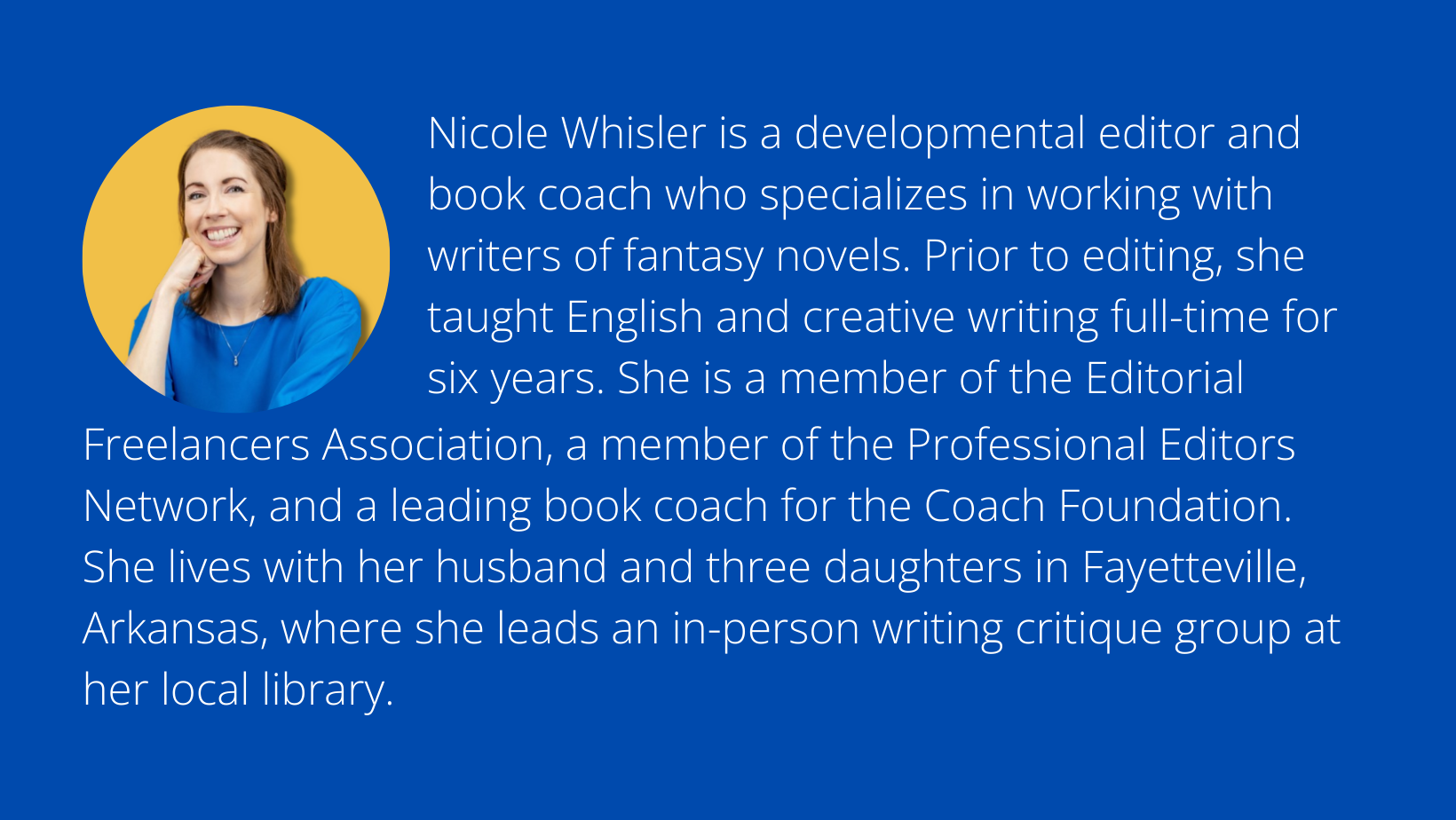Whisler Edits Blog

How to Get Into Your Character's Head without Using Italics
Discover in this post …
the primary reason readers stop reading a book.
the most effective way to resolve a lack of character–reader connection.
specific examples that illustrate exactly how to strengthen that connection.
Don't Let Readers Close Your Book
As a book coach for fantasy writers, I’ve worked with many authors to address common first-draft issues.
Plot holes. Lack of believability. Low stakes. Unbalanced exposition.
But I’ve found one item that appears more frequently than any other in early chapters. One item that automatically turns readers away, whether readers realize why they’re closing the book or not.
More than anything else, readers stop reading when they don’t connect with the protagonist. If they feel emotionally distant from your hero, they’re not likely to read on.
Contrary to what some writers think, readers don’t need to be similar to your protagonist to connect with them. They don’t need to share a hobby with your character, find a mutual personality trait, or even have age in common.

All they need is a deep dive into your point-of-view character’s head so they can understand who your character is.
If they understand your character, they can root for your character. They’ll see why the events of the plot matter and why they should invest themselves in the rest of the story. They’ll feel for your character as deeply as you do.
So how do we get into our point-of-view character’s head? One strategy is to use direct thoughts. Here’s an example:
No, she thought. It doesn’t matter anymore.
To be clear, there’s nothing grammatically incorrect about this use of italics. Writers have italicized direct thoughts for many years, and if used sparingly, especially for short, punchy statements, italics can work well.
Italics aren’t especially effective for lengthy thoughts:
No, Fiona thought. It doesn’t matter anymore. Ever since I confronted Harold in the dining room, everything has gone topsy-turvy. I wonder if he even loves me after what I did. I wouldn’t love myself if the tables were turned.
Lengthy italicized texts aren’t visually appealing, and readers don’t usually enjoy slogging through them. Instead, you could drop the italics, adjust the tense as necessary, and write something like this:
It didn’t matter anymore. Ever since Fiona had confronted Harold in the dining room, everything had gone topsy-turvy. Did he even love her after what she did? She wouldn’t love herself if the tables were turned.
Do you see how we’re in Fiona’s head, getting her thoughts without the italics? We’re in deep third-person point of view, so it isn’t necessary to say, “Fiona thought this” and “Fiona thought that.” We can simply state her thoughts themselves.
Until I started working one-to-one with fantasy writers, I didn’t realize how many writers were unsure how to get into their character’s head without using italics. I thought I’d take this opportunity to demonstrate how this can look.
Examples from a Middle Grade Fantasy Novel

On the first Tuesday of every month, I conduct a live critique on an opening scene submitted by a fantasy writer in my free, private Facebook group. One of these writers was gracious enough to allow me to use pieces of his middle grade fantasy novel as an example in this post.
I loved immersing myself in the writer’s opening chapter. Here’s a passage from his work in progress:
There had been weeks of dreary rain over the summer holidays, and school was about to start again. A bored Charlie was sitting at the dining table under the living room window, gazing out into the street, his chin nestled in his hands. He was deep in thought as he surveyed the hypnotic stream of water flowing along the street.
The story then moves on to describe Charlie’s mother coming home. Since the writer of this passage intended for his scene to be told from a close third-person point of view, I encouraged the writer to pause before moving on with the action. In this paragraph, we have an excellent opportunity to close the distance between readers and Charlie and get deeper into Charlie’s head. To get to know Charlie better, I want to know what makes Charlie bored. What is he deep in thought about? Is he bored because he loves to be outside? Because he misses his friends from school? Is he thinking about his dad’s disappearance (mentioned in the paragraph prior in the original submission)? Or how his plans for the rest of the summer are foiled because of the rain?
It may seem obvious, but whatever your character is thinking about will direct your readers’ focus. You get to choose when—and how often—to let readers into your point-of-view character’s interior world. Exposing their inner thoughts and reactions will tell readers who your character is at their core.
I’ve taken some creative liberties with the storyline, but here’s one way to rewrite the above passage to show Charlie’s thoughts without bogging down the paragraph with a jumble of italics:
There had been weeks of dreary rain over the summer holidays, and school was about to start again. Charlie sat at the dining table under the living room window and gazed out into the street, his chin nestled in his hands. Could his dad be out there, watching the same hypnotic stream of water flowing along the street? Or was he long gone? Mum said they’d never see him again, but Mum lied an awful lot. Either way, his dad would almost certainly miss another of his first days of school. Charlie counted. Was it three already? Three years without his dad squeezing his hand and saying, “Make it a good one, son”?
Something heavy—pointy and sharp like a rock—settled in Charlie’s chest. Maybe if he did the dishes when Mum asked him. Dropped his clothes in the laundry basket instead of on the floor. Said “I love you” to Mum more often, even when she snapped at him. Maybe then Dad would come back.
As I said, I’ve taken creative liberties with this passage. It might not be the writer’s intention to highlight the way Charlie misses his dad. But that’s the point! That’s the topic that stood out to me as I read this writer’s scene, so that’s what I chose to emphasize in the above rewrite. The writer can make a choice that’s aligned with his intention.
In this rewrite, readers know exactly what Charlie is thinking, so that instead of saying, “Charlie was deep in thought,” we know what he’s thinking about. This helps us understand his voice and feel connected to him. (One caveat: You don’t need to tell readers every thought on Charlie’s mind at every moment throughout the entire story. That would become a slog of its own. But I’ve found the opposite problem is much more common, which is why I’ve chosen to address it.)
Here’s a second example from the same middle grade fantasy manuscript—an argument between Charlie and his mother:
“So, can you explain how this has just 'literally' come through the letterbox when I’ve been sitting out in the car for the last few minutes talking to Maureen? I certainly didn’t see anyone pass by. Is this some kind of joke?” his mother said, raising her voice.
Charlie let out a sigh.
After this passage, Charlie’s mother continues to berate him, but Charlie’s personality and voice are minimized because I’m not clear on his reaction beyond the sigh. On one level, the sigh speaks for itself. It seems as if he’s tired of his mother’s nagging. But because I’m not privy to Charlie’s thoughts in the rest of the scene, I can’t say for sure. I don’t know if he’s angry, annoyed, or just feeling misunderstood.
Sometimes, especially in a high-stress situation like a fight scene, it's appropriate to save the bulk of the character's emotional reaction for after the fact. But in general, I recommend putting your character's thoughts on the page in real time so that readers can watch your character respond to a specific trigger in a natural way.
Here’s one way to rewrite the above passage so that Charlie’s inner world isn’t so hazy:
“So, can you explain how this has just 'literally' come through the letterbox when I’ve been sitting out in the car for the last few minutes talking to Maureen? I certainly didn’t see anyone pass by. Is this some kind of joke?” his mother said, raising her voice.
Charlie let out a sigh. Mice would eat cats before she ever let him be. Last week it was his dirty socks on the chaise lounge. Today it was the letter—which he’d had nothing to do with. He had half a mind to snap back at her and see how she liked it, but he wouldn’t. Of course he wouldn’t. That was the thing he knew clear as day about himself: he’d never be the one to stir up worse trouble. Trouble liked him well enough already.
With the added information, we have a stronger understanding of the dynamic between Charlie and his mother. We also know more about Charlie as a character and have a deeper sense of who he is as a person. Each insight we gain attaches us to him more firmly and prompts us to keep flipping those pages because we care about Charlie’s story.
Your Turn

Want to try this for yourself? Choose a few chapters you’ve written and highlight all the times you’ve already gotten into your point-of-view character’s head. Find a passage where that’s sparse, then use the above examples as a guideline as you sprinkle in your character’s thoughts. Remember that the thoughts shouldn’t be random. They should help direct your readers’ attention to what’s important in the scene, and they should provide readers with a clearer sense of who your character is and why readers should root for them.
For related content and additional examples, see my blog posts on character voice and character reaction.
I hope you’ve enjoyed today’s post about strengthening the emotional bond between readers and your protagonist. If you try the activity above, I’d love for you to email me at [email protected] and let me know how it went! I love building community with writers and readers, so never hesitate to reach out. (After all, if I’m not in your head, how will I ever know what you’re thinking?)
Do you want to learn how to write a story that makes your target readers stand up and cheer? If you’d like support from A to Z (from brainstorming to drafting to revising to publication), book a Discovery Call with me to see if you’re a good fit to join my book coaching program, Fantasy Footsteps: Road to Publication. And if you haven’t done so already, grab your Free Guide on how to hook readers from your story’s start!

